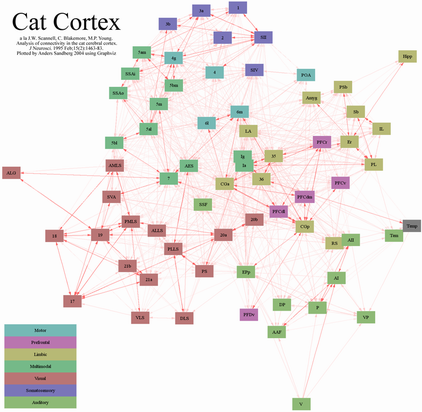April 25, 2004
Taking a Cat Map
A bit of visualizing entertainment: plotting the cat cortex connectivity data of JW Scannell, C Blakemore and MP Young, Analysis of connectivity in the cat cerebral cortex, Journal of Neuroscience, Vol 15, 1463-1483.
Again, I used Graphviz, coloring connections (this time directional) according to anatomical strength, and areas by their function (guessing a few, like the retrosplenial cortex that really looks very limbic).
The result is rather nice. One can see the starfish-like structure of sensory hierarchies merging in a transmodal middle discussed in Marcel Mesulam, From Sensation to Cognition, Brain (1998) 121, 1013-1052. Area 35/36 is perirhinal cortex, Ig/Ia insula, CGa/CGp cingulum, 6l/6m premotor cortex and they are heavily connected to the prefrontal cortices. Note the low-level interconnections between the somatosensory and motor systems and the medial temporal lobe memory system at the upper right.
I'm somewhat uncertain of some of the areas. Anybody who can tell me what PFDv, A6L, T, V and Temp are? I left out A6L (visual?) and T (limbic?), guessed that PFDv is dorsal prefrontal cortex, that V is something auditory and that Temp is all of the MTL.
Graphs like this should be taken with a grain of salt - some connections might have been missed or never even studied (who looks for a direct visual to motor link?), and even a few axons might have a huge influence functionally. The information we gain from them is a vision of the overall structure of an adaptive agent: hierarchies extracting regularities from the sensory input, using feedback to constrain or search for details. More decorrelated and distributed representations are combined into multimodal patterns, where they are linked to the biological and emotional state of the agent. This central state interacts with the behavior selection system that can activate motor output, as well as memory systems storing or retrieving older states. But there are plenty of cross-connections enabling quick responses and adaptive tricks like automatic attention direction to changing stimuli or fast emotional responses to fearful stimuli.
It would be neat to get the same atlas for the human brain. But that is still some way off, given how tricky it is to determine connectivity (we have CoCoMac for the Macaque). Not to mention the subcortical connectivity. Scannell has a paper with the thalamic connections, but they are not that fun - I want the rest of the subcortical menagerie too!
Posted by Anders at April 25, 2004 02:52 AM